Description
The Masked Rabbitfish (Siganus virgatus) is a striking fish known for its unique appearance and vibrant colours. It can grow up to a maximum size of around 10 inches (25 centimetres), making it a moderate-sized fish for aquariums.
Taxonomy
The Masked Rabbitfish belongs to the genus Siganus and the family Siganidae. It is closely related to other species within the Siganus genus, such as Siganus lineatus (lined rabbitfish) and Siganus canaliculatus (white-spotted spinefoot). The etymology of the genus name “Siganus” is derived from the Greek word “sigano,” which means “rabbitfish.”
Natural Habitat
The Masked Rabbitfish inhabits tropical coral reefs and rocky areas within its natural habitat. It prefers areas with ample hiding places, such as crevices and coral formations. These habitats provide the rabbitfish with protection and shelter, allowing them to feel secure.
Keeping the Masked Rabbitfish Healthy:
The Masked Rabbitfish requires a moderate level of care and is suitable for intermediate aquarists. Providing a well-maintained aquarium with stable water parameters is essential for their health and well-being. Regular monitoring of water temperature, salinity, pH levels, and filtration is recommended.
Special Requirements and Feeding
Masked Rabbitfish are herbivorous and have specific dietary requirements. They primarily feed on various types of marine algae, seaweed, and other plant matter. It is important to provide them with a well-balanced diet that includes high-quality commercial herbivore food, along with occasional offerings of fresh or frozen marine vegetables.
How Many Should I Keep?
Masked Rabbitfish can be kept individually or in small groups in a spacious aquarium. However, their territorial nature should be considered when deciding on the number of fish to keep. Providing ample swimming space and hiding spots will help minimize aggression among multiple individuals.
Lighting Preference
The Masked Rabbitfish does well under moderate to high lighting levels in the aquarium. Adequate lighting supports the growth of beneficial algae and provides a more natural environment for the fish.
Suitable Tank Mates
The Masked Rabbitfish is generally peaceful but may exhibit aggression towards similar species or other rabbitfish. Suitable tank mates include other peaceful fish species that inhabit reef or community aquariums. However, caution should be exercised when selecting tank mates to ensure compatibility and minimize territorial disputes.
In summary, the Masked Rabbitfish (Siganus virgatus) is a visually appealing fish that adds vibrancy to aquariums. It has specific dietary requirements and thrives in a well-maintained tank with stable water parameters. Providing suitable tank mates and ample hiding places will contribute to their overall well-being. With proper care, the Masked Rabbitfish can be a captivating addition to a marine aquarium setup.
Reproduction in the Wild
The Masked Rabbitfish (Siganus virgatus) follows a specific reproductive process in the wild to ensure the survival of their species.
The reproductive cycle of the Masked Rabbitfish begins with courtship behaviours. Males and females engage in various displays and movements to attract potential mates.
Once courtship is successful, the female releases her eggs into the water column. At the same time, the male releases sperm into the water to fertilize the eggs externally. This external fertilization method is common among many marine fish species.
The number of eggs produced can vary, ranging from hundreds to thousands, depending on the size and maturity of the female. The eggs are small and buoyant, allowing them to float freely in the water.
Breeding Siganus virgatus
- Set up:
To breed Masked Rabbitfish in captivity, it is essential to provide a well-maintained aquarium with appropriate conditions. The tank should have ample swimming space, hiding spots, and suitable water parameters.
- Courtship/Spawning:
In preparation for spawning, the male and female Masked Rabbitfish engage in courtship behaviours. This may involve displaying vibrant colours, extended finnage, and chasing each other. Once courtship is successful, the female releases her eggs into the water column, and the male releases sperm to fertilize them externally.
- Rearing: After fertilization, the eggs float freely in the water column. The larvae hatch from the eggs and undergo a period of development. During this time, they rely on their yolk sacs for nutrition. As they grow, the larvae undergo metamorphosis, gradually transforming into juvenile Masked Rabbitfish.
Sexual Dimorphism
Sexual dimorphism in the Masked Rabbitfish is not prominent, with males and females generally appearing similar in appearance. It can be challenging to visually distinguish between the sexes based on external characteristics alone.
Distribution
The Masked Rabbitfish, Siganus virgatus, is naturally distributed in the Indo-Pacific region, including areas such as the Red Sea, the Gulf of Aden, and the Arabian Sea. It can be found in various coral reef habitats, particularly those with ample hiding places and suitable food sources.
Summary
The Masked Rabbitfish (Siganus virgatus) is a visually striking fish known for its unique appearance. It follows a specific reproductive process in the wild, involving courtship, spawning, and the rearing of their offspring. Breeding Masked Rabbitfish in captivity requires a well-maintained aquarium setup with appropriate conditions. The distribution of the Masked Rabbitfish spans the Indo-Pacific region, including the Red Sea and the Arabian Sea. Understanding the reproductive behaviour and requirements of this species contributes to its successful breeding and conservation in captivity.
The Fish pictured here are representative only and the livestock you receive may vary in pattern, coloration, and shape.

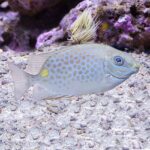

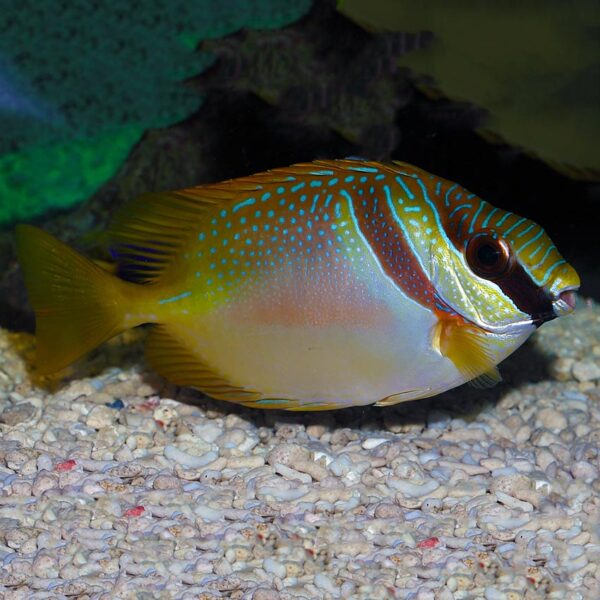

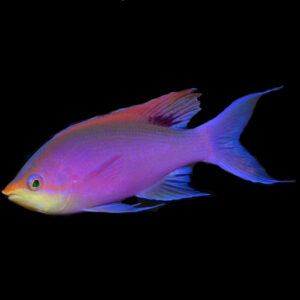
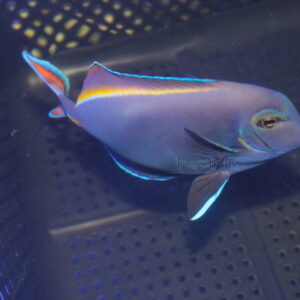
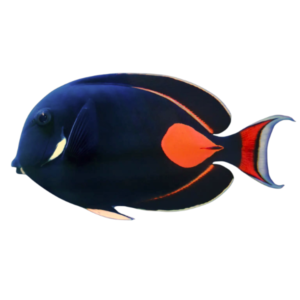
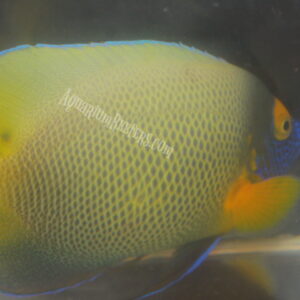
Reviews
There are no reviews yet.